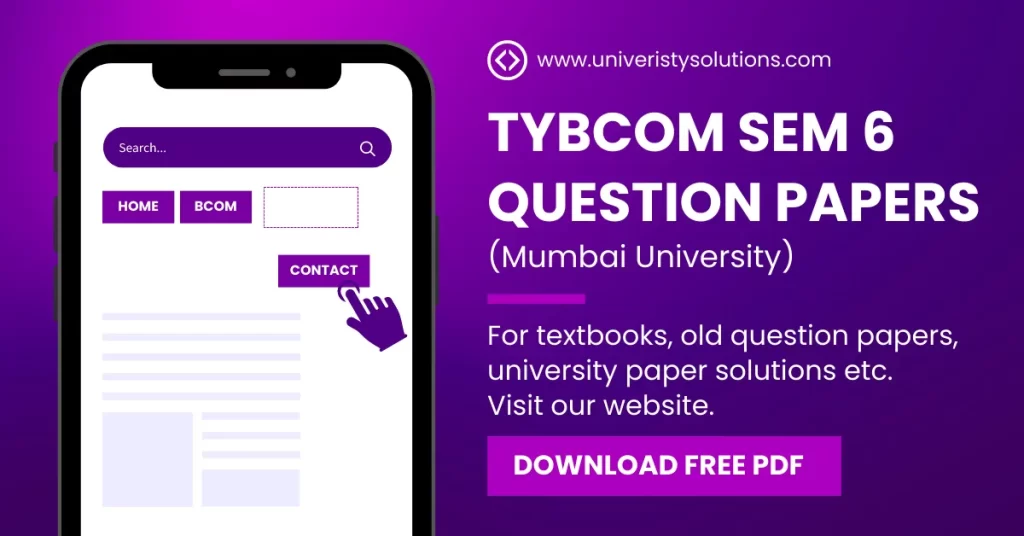
TYBCOM Sem 6 Economics Question Paper
April 2019
[Time: 3 Hours] [ Marks:100]
Please check whether you have got the right question paper.
- All questions are compulsory.
- Figures to the right indicate full marks.
- Draw neat diagrams wherever necessary.
Q.1 A) Select the right answers and rewrite the statements (Any 10) : (10)
1) According to the modern theory of international trade, ___________ is responsible for international trade.
a) Factors endowments
b) Labour
c) Money
d) None of these
2) ___________ refers to the rate at which a country’s exports exchange against its imports.
a) Foreign exchange
b) Balance of payments
c) Terms of Trade
d) Investment rate
3) Marshall and Edgeworth introduced a geometrical device to explain the gains from trade which is known as ________.
a) Indifference curve
b) Isoquant curve
c) BOP curve
d) Offer Curve
4) A protectionist policy has the following drawbacks ___________.
a) Consumers have to pay higher price
b) Producers get higher profits
c) Quality of goods may be affected
d) All of these
5) A tariff _________ .
a)” Increases the volume of trade
b) Reduces the volume of trade
c) ‘Has no effect on volume of trade
d) None of these :
6) __________ occurs when a group of countries agree to have free movement of factors of ‘production.
a) Free trade area
b) Customs Union
c) Common market
d) Preferential trade agreement
7) Rich countries have balance of payments deficit ________.
a) Sometimes
b) Never
c) Always
d) Every year
8) The official reduction in the value of a currency with respect to other currencies is known as _________.
a) Revaluation
b) Appreciation
c) Devaluation
d) Depreciation
9) The __________ declaration recognised that the TRIPs agreement should protect public health.
a) Bali
b) Doha
c) Bandung
d) Singapore
10) Foreign exchange market is _________ .
a) Grouping, by electronic means
b) Located only in London
c) Located only in New York
d) None of these
11) Hedgers enter into a foreign exchange market to ________.
a) Speculate
b) Promote exports
c) Cover risks
d) Promote imports
12) Holding everything else constant, an increase in interest rates in India will lead to _________.
a) Capital inflows into India
b) Depreciation of the INR
c) Capital outflows from India
d) A decrease in demand for goods and services.
Q.1 B) State whether the following statements are True or False. (Any 10) : (10)
- Adam Smith gave the first classical theory of international trade.
- Net barter terms of trade is also known as commodity terms of trade.
- If the cost ratios are equal there will be gain to both the countries and there will be trade.
- The cheap foreign labour argument is a legitimate argument against free trade because the cheap labour leads to low costs of production.
- If a country increases its tariff then imports will be more expensive.
- Nepal is a founder member of the European Union.
- A surplus in the current account of BOP implies that the country is lending to
- foreigners more than foreigners lending to it.
- Monetary and fiscal policies are used to correct BOP disequilibrium.
- The IMF has been given the mandate to negotiate multilateral rules in services.
- Majority of retail foreign exchange trading happens in forward market.
- If the U. S. dollar appreciates relative to the Swiss franc, Swiss chocolate will become cheaper in the U. S. A. ’
- Sterilised intervention is done through open market operations.
0.2 Attempt any two of the following: (15)
a) Bring out the differences between the Ricardian theory of international trade and the modern theory of international trade.
b) What are the factors affecting terms of trade?
c) Discuss the J. S. Mills theory of reciprocal demand.
Q.3 Attempt any two of the following: (15)
a) Discuss the arguments in favour of the policy of free trade.
b) Explain the economic effects of import tariffs.
¢) What are the reasons for Britain exiting (Brexit) the European Union?
Q.4 Attempt any two of the following: (15)
a) Discuss the structure of balance of payments of a country.
b) Explain different measures to correct deficit in the balance of payments.
¢) Discuss the WTO agreements with references to GATS.
Q.5 Attempt any two of the following: (15)
a) Discuss the factors influencing demand for and supply of foreign exchange.
b) Discuss the absolute and relative versions of the purchasing power parity theory.
¢) Explain managed flexible exchange rate system in India.
Q.6 Write short notes on any four of the following: (20)
a) Short comings of the Heckscher — Ohlin theory of international trade.
b) Objectives of commercial trade policy
c) The Marshall — Lerner condition
d) Spot and forward exchange rates
e) Types of economic integration
f) Functions of foreign exchange market
TYBCOM Sem 6 Economics Question Paper 2019 pdf
TYBCOM Sem 6 Question Papers 2019
Related Posts :
FYBCOM Subjects
SYBCOM Subjects
TYBCOM Subjects
FYBCOM Syllabus
SYBCOM Syllabus
TYBCOM Syllabus
Tips to score good marks in TYBCOM Exam
- Don’t wait until the last minute to start studying: begin early. You’ll have more time to learn the topic and solve questions, the earlier you start.
- Remain arranged: Plan a study schedule and stick to it. Take time to rest and refresh during breaks.
- Regularly review your notes: Regularly reviewing back your notes will help you keep the content in your memory.
- Practice, practice, practice: By working through sample problems and completing sample tests, you can identify your areas of weakness and become familiar with the exam’s format.
- Ask for assistance if you need it: If you’re having trouble with the subject, don’t be shy to ask for assistance. You can seek advice from your teacher, a classmate, or a tutor.
- Get a good night’s sleep: The night before the exam, be sure to get lots of rest. A mind that has got enough sleep is better prepared to memorize and recall information.
- Arrive early on exam day: Arrive early on the day of the exam to give yourself time to settle your worries and mentally prepare.
- Stay focused during the exam: Avoid being distracted during the exam by remaining focused. Take a deep breath and return your attention to the activity at hand if you realize that your mind is roaming.
- Don’t waste too much time on any one question: keep an eye on the time. If you start to struggle, leave it and return to it later.
- Review your exam after you’re done: After you’re finished, review your paper for a while. By doing this, you’ll be able to correct any mistakes you may have made and provide any answers you’re not sure about.
